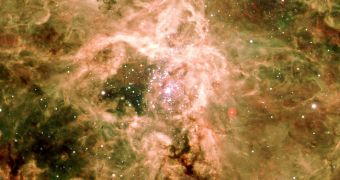Astronomers have been puzzled at the way the Large Magellanic Cloud produces stars for several decades. The galaxy, which is one of our own Milky Way's closest neighbors, contains numerous massive stars that are at least 100 times more massive than the Sun, and about 10 million times as bright. Though their presence can be easily observed in the night sky, determining their origin has proven to be a bit more challenging. But a recent study managed to identify the place where such a stellar behemoth was born, and finding that brought with it additional mysteries, Nature News reports.
The investigation was carried out by experts at the Moscow State University (MSU) Sternberg Astronomical Institute, who were led by astronomer Vasilii Gvaramadze. The researchers discovered a massive star flashing across the sky, and moving through the Cloud at a speed of no less than 130 kilometers per second. By all probabilities, the celestial body was ejected from its stellar nursery after it was created, most likely due to gravitational interactions with other objects at that location. The situation is not at all uncommon, and experts refer to these fast-moving bodies as runaway stars.
The data used to discover the new star were collected years ago by the NASA Spitzer Space Telescope, an infrared observatory that was extremely sensitive to this sort of objects. While peering through the image databases the telescope sent back over the years, Gvaramadze discovered the new body, which was called BI 237. The thing that made the body stand out from the crowd, and also that pinpointed its runaway origin, was the fact that it generated a bow-like shock wave. This is precisely what the team was looking for, aware of the fact that the 160,000 light-years that separate Earth from the LMC made discovery through regular means nearly impossible.
Details of the new investigation are scheduled for publication in an upcoming issue of the esteemed scientific journal Astronomy & Astrophysics. Gvaramadze details how the study lead him to believe that the object, BI 237, was actually generated inside the Cloud's Tarantula Nebula, an area of intense stellar formation, that has been receiving a lot of attention as of late. More precisely, the team leader concludes, the Nebula's LH 82 cluster is the most likely source for the runaway star, which apparently was produced around 2 million years ago.

 14 DAY TRIAL //
14 DAY TRIAL //